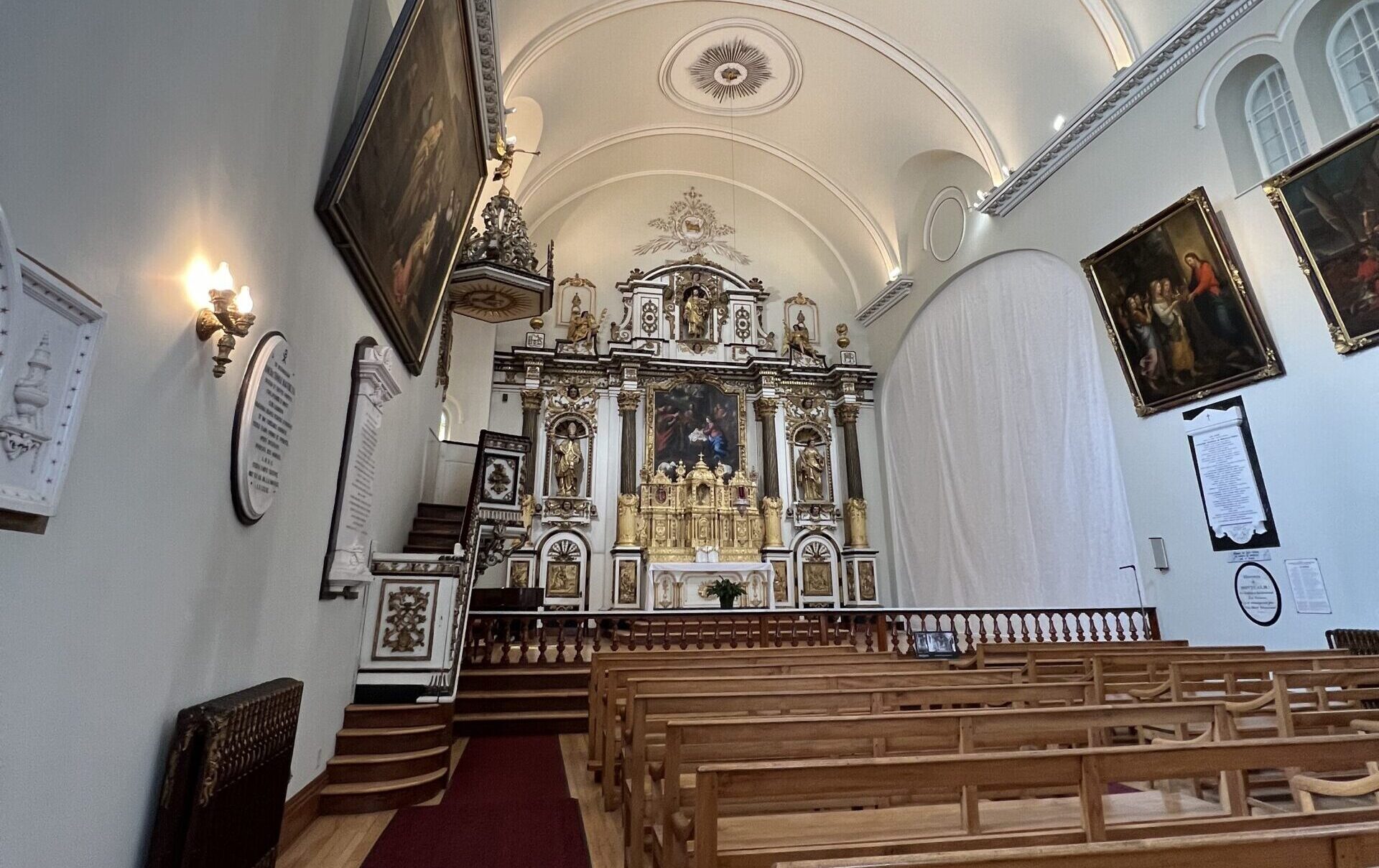
NCW virtual resident Juliette Bernatchez discovers parallels between UNESCO Cities of Literature Québec and Norwich.
In this commission produced during a virtual residency exchange, Juliette Bernatchez writes about how she interacts with Québec, referencing different texts and videos as she makes her way through the city. She imagines herself traversing through Norwich in a similar fashion, down the cobbled streets of Elm Hill instead of the rue des Remparts, charting a different river.
Juliette also links the two cities by comparing the lives of Marie Guyart, or Marie de l’Incarnation, the first author of mention in French who was of Canadian origin, and Julian of Norwich, who wrote the first work in English written by a woman. Writers connect across different spaces and times, not unlike her own virtual residency exchange with Megan Bradbury, an author based in Norwich.
This virtual residency exchange was made possible with the support of the Québec Government Office in London and l’Entente de développement culturel entre le gouvernement du Québec et la Ville de Québec. Click here for the French webpage on the residency exchange.
like flames
By Juliette Bernatchez
Trans. Claire Gullander-Drolet
I walked for some time to find the pub. Weaving around the groups of tourists ambling over the network of cobblestone streets and culs-de-sac, I settled in for a pint in the stone-walled basement once I reached my destination.
When I was eighteen we’d come here often, especially after a night of drinking with friends from across the river. These touristy streets would be deserted after the final ferry. We’d come for a final pint at the Pape-Georges or l’Oncle Antoine before heading back towards the haute-ville. I was eighteen years old and felt as though I was living in a film set.
It was wandering to discover the city in all its facets and from afar
Turning homeward, the ramparts would be overflowing with friends. The bars had emptied out and everyone knew one another, shouted greetings to one another along the walkways. The walk home was always long, drawn out further still by what was left of the party.
In retrospect, there was something quite absurd about crossing the river for a night out with friends when the whole city was ours. To make that whole trek for one dirty bar when the coolest dive of all, the Sacrilège, was just two steps from my home. It was more, I think, about the act of wandering itself. Wandering to stretch out time, to see where it resisted or crystallised. It was wandering to discover the city in all its facets and from afar, bordered by the river, gleaming and whole.
*
I took a few photos for my friend in Norwich.
Norwich and Québec resemble each other in a funny way: the cobblestones, the straight-cut streets, fortifications
There is something about Autumn in Québec—its colors, its textures. The way it distills impermanence. There’s a freshness that startles, a kind of ardour to the sun. For close to seven years, I’ve floated through Québec autumns with the same orange jacket. The orange jacket is like a rupture, a new beginning. Another facet of me.
My friend does the same. When she roams the streets of Norwich, she does so, perhaps, cloaked in her own lucky charm.
*
Norwich and Québec resemble each other in a funny way: the cobblestones, the straight-cut streets, fortifications. A single imposing castle. The deserted streets of Elm Hill resemble those around the rue des Remparts. Both cities are resistant to bad taste, as though frozen. They’re heightened, instead, by the cycles that pass by and eventually burn away.
*
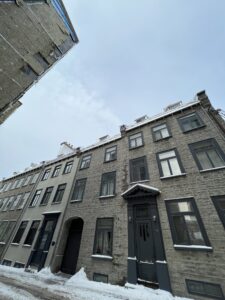 If we turn on the first street to the left after passing the porte Saint-Jean, the calm takes over once again. The streets adjust their breath to the rhythm of the neighborhood. Vines scale the walls, and the skylights visible from the street strain to conceal their secrets, burying them from release. A little further, the stone walls enclosing the Augustine cloisters loom overhead. Silence reigns in this fortified area of the city.
If we turn on the first street to the left after passing the porte Saint-Jean, the calm takes over once again. The streets adjust their breath to the rhythm of the neighborhood. Vines scale the walls, and the skylights visible from the street strain to conceal their secrets, burying them from release. A little further, the stone walls enclosing the Augustine cloisters loom overhead. Silence reigns in this fortified area of the city.
*
The cloisters are marked by two kinds of silence: simple, and expansive. We speak very quietly, or not at all. There’s a tendency to see silence as restriction, though I see it as a kind of invitation: an invitation to let one’s thoughts romp about. So that what happens in our heads is louder, more raucous than the rest.
In silence, frowns and grins alike are permitted.
There is much I can say with my features.
To be in silence does not mean to silence oneself. Some women propel themselves through language, and in writing, capture the essence of who they are. They are proof that their life is worthy of mention. That they are unique, complex, unequaled.
*
« To write is also not to speak. It is to keep silent. It is to howl noiselessly. » Marguerite Duras, Writing.
*
When Julian of Norwich wrote Revelations of Divine Love in 1373, she wrote in English, the language of the people. At the time, women were not permitted to write, and certainly not in the Latin form that was taught in the universities. She is thus recognized as the first woman of English letters.
Critics observe that there must have been an unusual motivation at play to push a woman to write as Julian did. Her motivations were indeed mystical in nature, spurred by encounters with apparitions that she experienced while battling an illness that left her on the verge of death. Her first revelation: that God is both father and mother at once. God, after all, she associated not with authority but with goodness, kindness, and protection. After overcoming her illnesses, Julian became an anchorite and found herself drawn to a small cell attached to St. Julian’s church of Norwich, where she derives her historical name. She became a celebrated spiritual counselor from 1390 to her death in 1416.
Her prophecies might well have been silenced, as they were dangerous for the time. Fortunately, she chose to write them in a language that many know and understand, and which is accessible to us still today.
*
For many historians, Marie Guyart—otherwise known as Marie de l’Incarnation—is the first author of mention in French, as well as in Latin letters, of Canadian origin. She is considered the first woman to have written an intimate history of Québec, which she did through the almost 13,000 letters that comprise her archival fonds. Her letters enabled increased knowledge of missionary life and the founding of the Ursulines in New France. It’s also said that she wrote some of the most erotic prose in Québécoise literature, her mystic prophesies expressed through the prism of desire and sensuality.
Her personality… sent everything aflicker
There’s a duality to Marie’s character, a kind of push-and-pull between her strong personality and life in the cloisters. She is described as embodied, intense, and confident, traits that strained against the silence and moderation that cloistered life demands. Her predilection for the pleasures of the senses likewise anchored her to the earthly world, moving her further from her divine objective. Her personality, stronger than herself, even, sent everything aflicker.
*
My friend sends me a photo of her in front of the statue of Julian of Norwich, at the Norwich cathedral. Julian stands tall and straight, vigilant, guarding the entrance. My friend smiles, a light in her eye.
Looking at her photos, I see myself enter St. Julian’s church and tread across her cell. I see myself open the window that leads to the outside yard, greeting the passersby. In this vision I am introspective, ready for anything, in this church rebuilt after the bombs of the Second World War.
I send her photos in return. The Ursuline chapel where I found Marie de l’Incarnation’s tomb, an ostentatious construction in a heritage building. The magnificent parc de l’Artillerie, always vacant, no matter the time of day.
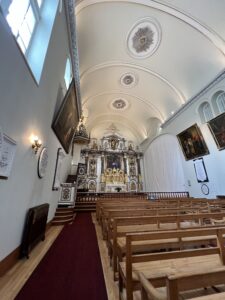

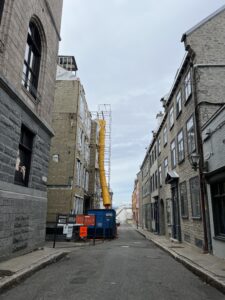
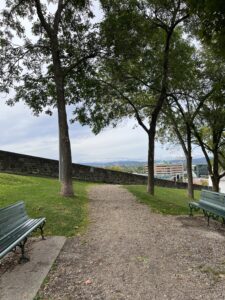
*
Near the National Assembly stands the Complexe G, the tallest skyscraper in Québec City. The building is named after Marie Guyart. At the very top is a tourist attraction, l’observatoire de la Capitale, that offers a panoramic view of the city, which you can also see live on its website. Today in late November, the greying stretches out from east to west.

During the building’s construction in 1971, the freshly-poured concrete on the twenty-ninth floor fell victim to a fire. It’s said that the blaze could be seen from several kilometers around. Though the building only became “Complexe G” in 1989, I am convinced that Marie Guyart was there after the last worker left on that day in March 1989, keeping watch over her building to come. And I’m equally convinced that every day at 5 p.m, when the tourists empty the floor, her ghost reveals itself on the observatory deck.
*
Googling my two icons, I come across several promotional objects featuring Julian of Norwich, including coffee mugs. Supposed effigies of Marie de l’Incarnation are less interesting: a twenty-cent stamp, a costume of the virgin Mary.
Marie and Julian: two mystic women of letters
I heard that Marie de l’Incarnation has a second sculpture in Québec City. I still haven’t seen it in person. In photos, she is perched very high up, on one of the exterior walls of the National Assembly.
*
Marie and Julian: two mystic women of letters, thousands of kilometers apart.
They flicker over their cities like flames.
*
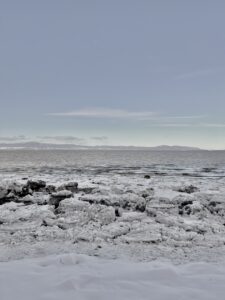
It’s November and I’ve got a front row seat to the great tides of the Saint Lawrence river at Saint-Vallier, where we have a family chalet. The wind cuts my breath, and ice is forming all along the river. I have trouble descending to the shoreline, such is the extent of the snow piled up all around. On my way, I pass my favorite rock and two bird carcasses, white on white.
The next day the tide is lower and the river is calm. Yesterday’s waves were grandiose, and it’s no longer the snow blocking my way, but the large jagged masses of ice pushed several meters to the river. I’ve lost my guides from yesterday. The waves took them away.
*
We move how we can, as waves, and silence tells the story.
*
I found Marie de l’Incarnation’s second statue. I have to crank my neck up to see her, as she towers over everyone else from on high. She reigns alongside Margeurite Bourgeoys, above Champlain, Maisonneuve, Wolfe, Frontenac. Higher than all the men.

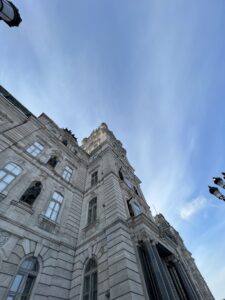
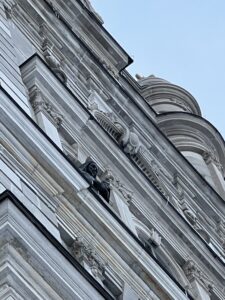
*
This last line, I write from my favorite spot in the house of literature. The darkness has just fallen, my cheeks are red from a long walk. It’s December 30th. A fresh bed of snow has accumulated, and I take some time to breathe.


As I wrote and rewrote, lived and observed these past few months, one theme cropped up again and again: time, and movement. What time (and movement) can do, what they require, and what they make possible. And while it’s all well and good for me to want to tell these things, I sometimes have the feeling that there are no words left that haven’t already been written.
« There is nothing staid, nothing settled, in this universe. All is rippling, all is dancing; all is quickness and triumph.» Virginia Woolf, The Waves
______________________
Works cited
Marguerite Duras, Écrire, Paris, Gallimard, Folio, 1993, p.71
Virginia Woolf, Les Vagues, Paris, Gallimard, Folio Classique, 2012, p.79
Patricia Smart, De Marie de l’Incarnation à Nelly Arcan, Montréal, Boréal, 2014.
Julian of Norwich, Revelations of Divine Love, Penguin Classics, 1998.
Christine Cheyrou, Les Ursulines de Québec : carnets de mémoires, Montréal, Fides, 2015.

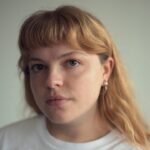 Juliette Bernatchez has a master’s degree in literary studies and is a cultural worker and author. Since 2018, she has accumulated contracts in several festivals and cultural organizations in Quebec City. In February 2021, she co-founded and co-directed CONTOURS, a literary arts production and distribution organization. As an author, she has performed in various artistic events and can be read in the magazines Zinc, Le Sabord and Françoise Stéréo. In the summer of 2022, she was awarded a creation grant from the Conseil des arts et lettres du Québec to write her first book. Photography by Justine Latour.
Juliette Bernatchez has a master’s degree in literary studies and is a cultural worker and author. Since 2018, she has accumulated contracts in several festivals and cultural organizations in Quebec City. In February 2021, she co-founded and co-directed CONTOURS, a literary arts production and distribution organization. As an author, she has performed in various artistic events and can be read in the magazines Zinc, Le Sabord and Françoise Stéréo. In the summer of 2022, she was awarded a creation grant from the Conseil des arts et lettres du Québec to write her first book. Photography by Justine Latour.
You may also like...
‘little river’: a commission by Juliette Bernatchez
As part of a Norwich-Québec virtual residency exchange, Juliette Bernatchez traces Québec history

7th March 2023
Solitude/Fortitude
Thoughts on loneliness, music and writing with, or without others from an NCW virtual resident

17th February 2023
Julian of Norwich & biscuits with Vahni Capildeo and Jeremy Noel-Tod
An Imagining the City podcast

29th April 2021






